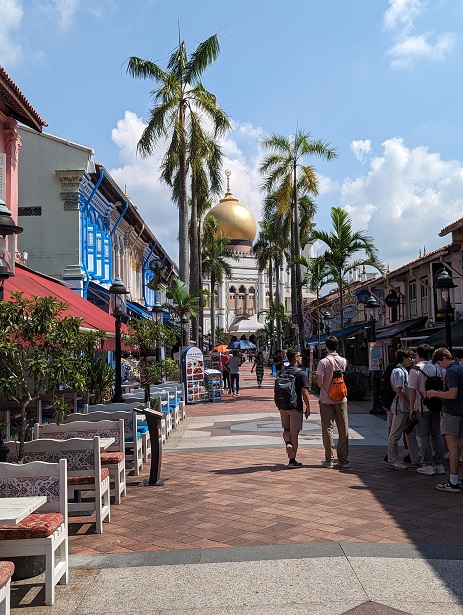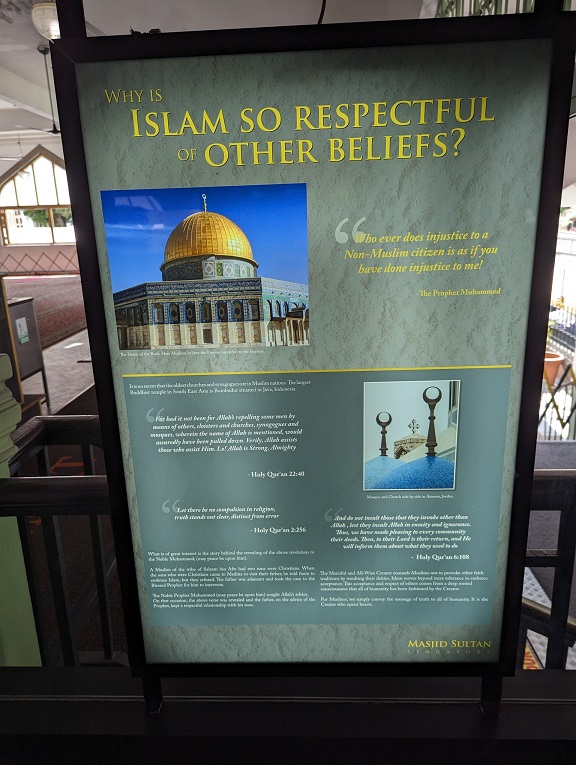home_news
From Arab and Muslim Merchants to Christian Missionaries: Intertwined Narratives Shaping Southeast Asian Identities

My name is Andrew Milewski, currently a Jesuit preparing for future ordination as a Catholic priest and teacher at Saint Joe’s Prep in Philadelphia. My journey into Arabic language and culture began during my studies at Loyola University Chicago, from 2020 to 2023, where I completed Masters degrees in Social Philosophy and Theology. Engaging deeply with the Arabic language program and Muslim Student Association at Loyola, I gained a profound appreciation for the Arab world's linguistic and cultural nuances. In 2022, a summer immersion in colloquial Levantine Arabic at the American University of Beirut further enriched my understanding and deepened my connection to my own Lebanese ancestry. This background has uniquely prepared me to teach world religion and foster intercultural dialogue at St. Joe’s Prep here in Philadelphia.

In June 2024, I had the privilege of accompanying sixteen of our high school students and two other teachers on a cultural immersion trip through Taiwan, Singapore, and Malaysia. This expedition aimed to broaden our students’ understanding of global citizenship and foster awareness of cultural diversity in an interconnected world. Throughout the journey, we explored various facets of these societies, from historical landmarks to contemporary issues, such as environmental destruction from palm oil, all while engaging deeply with local communities and their cultural practices. When we visited Malaysia, a predominantly Muslim nation, it was easy to see how Islamic culture has a significant impact on daily life. Malaysia’s Muslim-majority status influences its culture in noticeable ways, such as the widespread availability of halal food, including popular items like chicken sausage. The calls to prayer from mosques can be heard throughout the day, adding a spiritual dimension to urban areas and the rural environments covered with palm trees. Islamic values are integrated into Malaysian customs, observed through traditions like Ramadan and Eid celebrations. On the last day of our visit, the highway was blocked up from people traveling for Eid al-Adha. Mosques, central to community life, reflect the country's architectural and religious heritage, and many were visible as our student group walked the streets of Melaka.

One highlight of our trip that stood out was exploring how Arab culture has influenced Southeast Asia, particularly its impact on languages like Malay, commonly spoken in both Singapore and Malaysia. Despite belonging to the Austronesian language family, Malay has absorbed Arabic influences over centuries of trade, religious exchanges, and cultural interactions. From the 7th century onwards, Arab and Indian traders brought Islam to the region, leading to the incorporation of Arabic vocabulary into governance, religion, and daily life. An easy example of this exchange is seen in the Malay greeting “selamat datang,” where the word “salaam” from Arabic is evident. Historically, Malay was written using a script adapted from Arabic, with additional letters to accommodate sounds unique to Malay that were not present in Arabic. One example of a letter adapted from Arabic for Malay is the letter “ڤ” (ve), which represents the sound /v/ in Malay. This sound exists in Malay but not in classical Arabic, so the letter “ڤ” was added to the adapted Arabic script used historically to write Malay. While Malay now uses the Latin alphabet, this adaptation underscores its linguistic evolution shaped by Arabic heritage.

Here are some examples of Arabic loanwords that have greatly enriched the Malay language in different areas. Words like "sebab" (reason), "syarikat" (company), and "badam" (almond) show how Arabic has influenced daily conversations and food-related vocabulary. In governance and legal contexts, words such as "akta" (act), "dakwah" (sermon), and "harta" (asset) reflect Arabic's impact. Religious terms like "iman" (faith), "solat" (prayer), and "puasa" (fasting) emphasize Arabic's role in Islamic teachings within Malay culture. These loanwords not only show how Arabic has blended into the Malay language but also reveal the historical and cultural connections between Arabic-speaking societies and the Malay Archipelago. Additionally, Arabic words like "maaf" (sorry), "waktu" (time), "saat" (moment), and "miskin" (poor) have seamlessly integrated into Malay, enriching its vocabulary with specific meanings. "Maaf" is used to apologize or express regret, while "waktu" and "saat" both refer to time in different contexts. "Miskin" indicates economic hardship or poverty, reflecting Arabic's influence on expressing socio-economic conditions among Malay-speaking communities. These examples illustrate not only how words are borrowed linguistically but also how cultures exchange and connect historically, especially between Arabic-speaking societies and Malay culture.

During our time in Singapore, visiting the Sultan Mosque on Arab Street was a memorable experience. This mosque has a significant history dating back to the early 1800s. It was built by Sultan Hussein Shah of Johor to serve the growing Muslim community in Singapore, which included Arab traders and settlers who had strong ties across Southeast Asia. Islam came to Singapore through Arab and Indian traders who traveled here as part of a big trading network linking the Middle East, India, and Southeast Asia. They didn't just trade goods; they also brought their religion and culture, leaving a lasting mark on Singaporean society. The Sultan Mosque itself is a beautiful example of Islamic architecture. Inside, you can see intricate Arabic calligraphy and geometric designs that reflect the artistic and spiritual aspects of Islam. These decorations are not just for looks; they carry deep meanings rooted in Islamic teachings and traditions.
.jpg)
Entering the Sultan Mosque on Arab Street in Singapore was a memorable experience for me and the students. As we walked in, I pointed out the sign which had the Shahada in English and Arabic.I read it out in Arabic and explained its meaning to the students. A friendly Egyptian man overheard me, and we had a brief chat about the mosque and its cultural significance in Singapore. Inside, I noticed signs reminding men and women to cover their legs if they were wearing shorts, and another sign requesting visitors not to sleep inside the mosque, which made sense given the comfortable carpeted floor. I took the opportunity to discuss the pillars of Islam with the students, focusing on prayer, fasting, and the upcoming Hajj pilgrimage, which would be happening soon. It was an educational visit that combined cultural exploration with religious learning in a historic place of worship.

We ended our trip in Melaka, where we explored Jonker Street and contemplated Jesuit identity at St. Paul’s, the first Catholic church in Asia, which stood uphill from the local mosque. Reflecting on this, I was struck by how historical narratives intertwine with cultural interactions, including those of Arab merchants, Christian missionaries like St. Francis Xavier, and us educators and students today. These encounters exemplify a commitment to understanding and solidarity across diverse cultural landscapes. I was grateful to be a part of this experience which reinforced my belief in the importance of language as a bridge between cultures and highlighted the enduring impact of Arab cultural contributions in shaping Southeast Asian identities.


